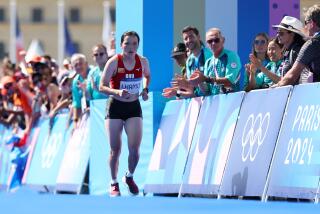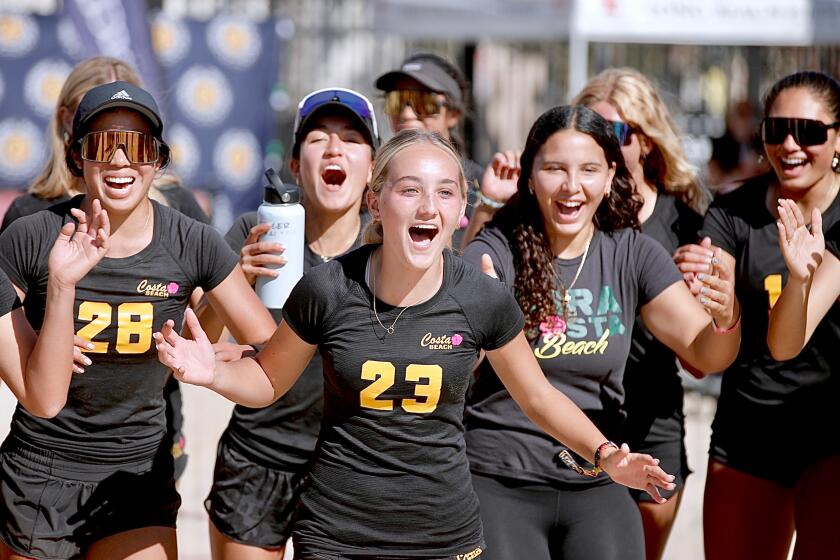Espinosa Wins New York Marathon : Running: He leads impressive showing by Mexican runners. Pippig dominates women’s race.
- Share via
NEW YORK — Running from his past and into history, Andres Espinosa of Mexico dared not look back. As he ran alone into the leafy shade of Central Park, Espinosa knew that he was leading the New York City Marathon, but he did not allow himself to glance behind.
Espinosa on Sunday outraced his agonizing history in this race--finishing second the last two years--and won, leading a group of Mexican runners to a remarkable finish.
Espinosa’s winning time of 2 hours 10 minutes 4 seconds was all the more impressive given the race conditions--unseasonably warm temperatures in the 70s during the race caused widespread problems for the race’s 28,000 back-of-the-pack runners.
Espinosa, a former laborer at a steel mill, led countrymen Arturo Barrios, who finished third in 2:12:21, and Inocencio Miranda, who was sixth in 2:12:52. The race served notice that Mexican runners are not merely dominant in the middle distances.
Bob Kempainen, a young medical student from Minnetonka, Minn., became the first American to place in the top five since Ken Martin finished second in 1989. Kempainen, a 1992 Olympian, steadily picked off the dregs of the lead pack, drew even with Espinosa in the hills of Central Park and finished second. Kempainen’s time of 2:11:03 is the best by an American this year.
Because of the elaborate bonus schedule that rewards American performances, Kempainen earned $45,000 and Espinosa $40,000.
After his convincing victory Sunday, Espinosa acknowledged memories of his two second-place finishes here.
Crossing the finish line, he said, “was like a big relief. You lose all tension.”
While the lead in the men’s race changed nearly every mile, the women’s race was controlled by Germany’s Uta Pippig, who is also a medical student. Pippig won easily in 2:26:24, a personal best. Pippig’s victory continues a remarkable streak that began in 1987--she has finished in the top three in nine consecutive marathons.
Olga Appel of Durango, Mexico, made her move at 16 miles and finished second in a personal best time of 2:28:56. Nadia Prasad of France was third, also in a personal best, in 2:30:16.
The American women did not fare as well. Olympian Kim Jones was treated and released from New York Hospital for a severe asthma attack and Anne Marie Letko, who finished eighth in the 10,000 meters at the 1993 World Championships and was running in her first marathon, was treated and released from Lennox Hill Hospital for hypothermia. Neither runner finished the race.
The heat was expected to add significant chunks of time to the results, but most of the elite runners ran surprisingly fast times. Which is not to say that the weather didn’t exact a physical toll.
“It (the heat) was just annihilating people,” said Keith Brantly, a Floridian who trained with Kenyans for his first marathon. He placed fifth.
Little seemed to bother the Mexican runners, who train under the most extreme of conditions--heat, cold and nosebleed altitude.
The performance by Mexican runners was merely an affirmation of current standards. But the two top-five finishes by American men was yet another in a series of sporadic ‘breakthrough’ races, meant to herald the return to prominence of this nation’s marathoners.
The four elite Americans found themselves running together at 13 miles. Suddenly united were Brantly, Kempainen, Don Janicki and Steve Plasencia. Their American pack broke up quickly. Kempainen was starting his second-half surge. Plasencia finished 16th and Janicki 19th.
Kempainen, a reflective sort, noted the success of American men on the track. Those middle distance runners then move to the marathon.
“It seems that there may be a cycle going on,” he said. “It’s great in terms of developing the younger runners.”
Kempainen turned on to First Avenue, the marathon’s famous tunnel of sound, running stride for stride with Espinosa. Kempainen said he entertained thoughts of winning. But, as the American discovered, “He (Espinosa) shifted into a gear I didn’t have.”
Kempainen followed Espinosa into Central Park, but with the undulating hills and course turns, he could not see the leader. Espinosa never looked back and erased thoughts of second place with his steady and determined run to the finish.
“I was not trying to take second,” he said. “I knew I would win.”
Mexico and Kenya had the largest group of elite runners in the field. Runners from both countries are known to work together during races--on Sunday a group of Kenyan runners passed a single water bottle among themselves.
The Mexicans’ style is to train together, but it’s every runner for himself during the race. Bravado plays a role. Salvador Garcia, a lieutenant in the Mexican army, offered a challenge to the Kenyans before the race--roughly translated as “Mexicans are better.”
Garcia, a prickly personality, denied making the comment.
Pippig, the women’s winner, doubted her lead, even as she sped away from the rest of the field.
“I looked back sometimes, and I was leading by two minutes,” she said. “It’s crazy to look behind so much. I couldn’t believe that I was winning so easily.”
More to Read
Go beyond the scoreboard
Get the latest on L.A.'s teams in the daily Sports Report newsletter.
You may occasionally receive promotional content from the Los Angeles Times.











